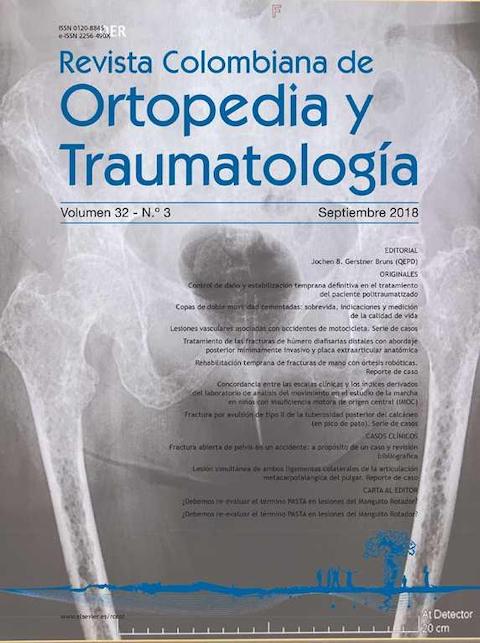Treatment of distal diaphyseal humeral fractures with minimally invasive posterior approach and anatomical extraarticular plate
DOI:
https://doi.org/10.1016/j.rccot.2017.11.005Keywords:
humeral shaft fractures, distal third humeral fractures, minimally invasive approach, posterior approach, anatomical plateAbstract
Background: Diaphyseal humeral fractures correspond to 3-5% of all fractures. The proportion of these fractures in which the distal third of the diaphysis is involved is variable with estimated incidences between 10-48%. The aim of the study is to evaluate the functional results and rate of fracture consolidation for a group of patients with distal third diaphyseal humeral fractures managed using a minimally invasive technique through a posterior approach.
Materials and methods: Twenty-two patients (mean age of 36 years) were evaluated between 2013 and 2016. Functional assessment was performed using the DASH abbreviated functional scale. Shoulder and elbow mobility range of motion were measured with goniometry, and pain was measured following the VAS scale.
Results: All fractures consolidated successfully, with two cases exhibiting delay in consolidation. Radial nerve injury prior to the intervention was progressively recovered without the need for supplementary tendons transfers. Functional results were satisfactory for ten patients that completed more than one year of follow-up.
Discussion: Minimally invasive technique with posterior approach in the treatment of this particular pattern of humeral fractures seems to show a biological advantage in allowing complete consolidation in all patients. Iatrogenic radial nerve injury does not appear to increase in relation to its isolation and protection in the proximal portion of the triceps.
Evidence level: IV.
Downloads
References
Tytherleigh-Strong G, Walls N, McQueen MM. The epidemiology of humeral shaft fractures. J Bone Joint Surg Br. 1998;80:249-53. https://doi.org/10.1302/0301-620X.80B2.0800249
Ruedi T, Murphy WM. AO Principles of Fracture Management. Stuttgart-Nueva York: Thieme. 2000.
Igbigbi PS, Manda K. Epidemiology of humeral fractures in Malawi. Int Orthop. 2004;28:338-41. https://doi.org/10.1007/s00264-004-0596-4
Zagorski JB, Jennings JJ, Burkhalter WE. Comminuted intraarticular fractures of the distal humeral condyles Surgical vs. nonsurgical treatment. Clin Orthop Relat Res. 1986;202:197-204. https://doi.org/10.1097/00003086-198601000-00026
Robinson CM, Hill RM, Jacobs N. Adult distal humeral metaphyseal fractures: epidemiology and results of treatment. J Orthop Trauma. 2003;17:38-47. https://doi.org/10.1097/00005131-200301000-00006
Livani B, Belangero WD, Castro de Medeiros R. Fractures of the distal third of the humerus with palsy of the radial nerve: management using minimally-invasive percutaneous plate osteosynthesis. J Bone Joint Surg Br. 2006;88:1625-8. https://doi.org/10.1302/0301-620X.88B12.17924
Kobayashi M, Watanabe Y, Matsushita T. Early full range of shoulder and elbow motion is possible after minimally invasive plate osteosynthesis for humeral shaft fractures. J Orthop Trauma. 2010;24:212-6. https://doi.org/10.1097/BOT.0b013e3181c2fe49
Apivatthakakul T, Phornphutkul C, Laohapoonrungsee A, Sirirungruangsarn Y. Less Invasive Plate Osteosynthesis in Humeral Shaft Fractures. Oper Orthop Traumatol. 2009:602-13. https://doi.org/10.1007/s00064-009-2008-9
Livani B, Belangero W. Bridging plate osteosynthesis of humeral shaft fractures. Injury. 2004;35:587-95. https://doi.org/10.1016/j.injury.2003.12.003
Gallucci G, Boretto J, Vujovich A, Alfie V, Donndorff A, De Carli P. Posterior Minimally Invasive Plate Osteosynthesis for Humeral Shaft Fractures. Tech Hand Up Extrem Surg. 2014;18: 25-30. https://doi.org/10.1097/BTH.0000000000000017
Hervás MT, Navarro Collado MJ, Peiró S, Rodrigo Pérez JL, López Matéu P, Martínez Tello I. Spanish version of the DASH questionnaire. Cross-cultural adaptation, reliability, validity and responsiveness. Med Clin (Barc). 2006;127:441-7. https://doi.org/10.1157/13093053
Zhiquan A, Bingfang Z, Yeming W. Minimally invasive plating osteosynthesis (MIPO) of middle and distal third humeral shaft fractures. J Orthop Trauma. 2007;21:628-33. https://doi.org/10.1097/BOT.0b013e31815928c2
Balam KM, Zahrany AS. Posterior percutaneous plating of the humerus. Eur J Orthop Surg Traumatol. 2014;24:763-8. https://doi.org/10.1007/s00590-013-1355-2
Gallucci GL, Boretto JG, Alfie VA, Donndorff A, De Carli P. Posterior minimally invasive plate osteosynthesis (MIPO) of distal third humeral shaft fractures with segmental isolation of the radial nerve. Chir Main. 2015;34:221-6. https://doi.org/10.1016/j.main.2015.06.007
Gallucci G, Vujovich A, Boretto J, Alfie V. Técnica mínimamente invasiva por vía posterior para el tratamiento de fracturas diafisiarias de húmero. Rev Asoc Argent Ortop Traumatol. 2013;78:64-73. https://doi.org/10.15417/245





